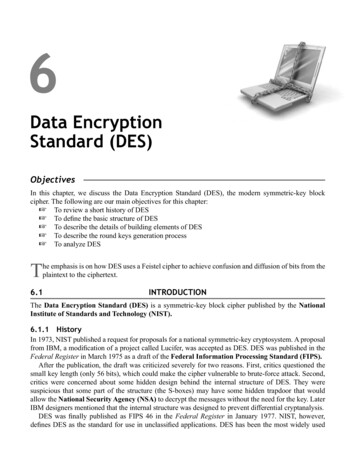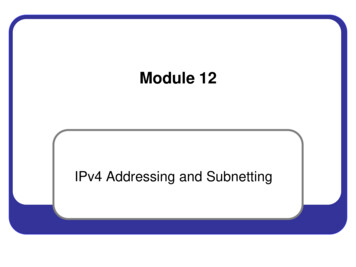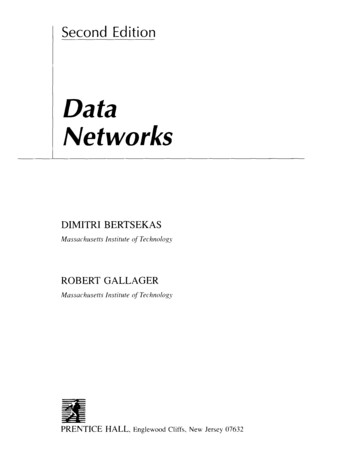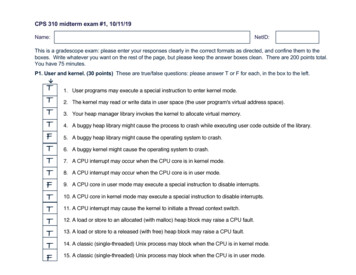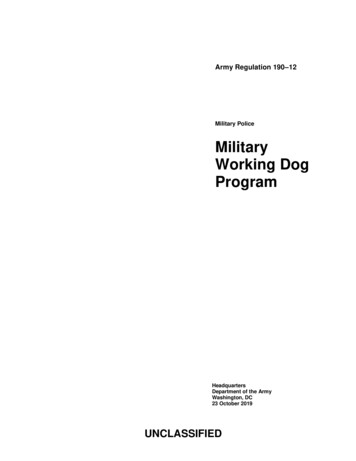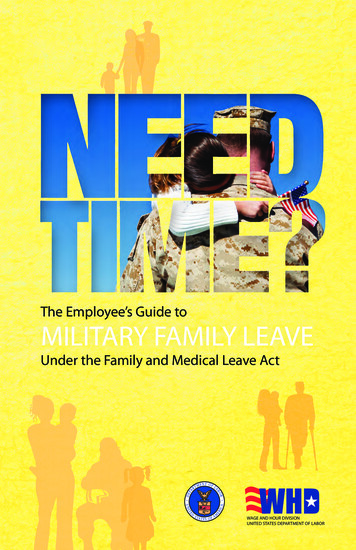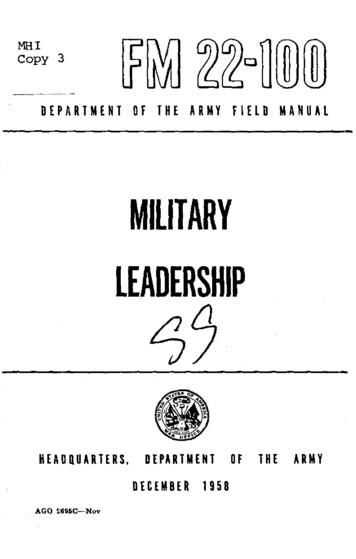
Transcription
MEICopy 3ToDEPARTMENT OF THE ARMY FIELD DECEMBERAGO 1:G96C-Nov1958OFTHEARMY
* FM 22-100FIELD MANUALNo. 22-100HEADQUARTERS,DEPARTMENT OF THE ARMYWASHINGTON 25, D. C., 2 December 1958MILITARY LEADERSHIPParagrarhsCHAPTER 1.Section I.II.CHAPTERPage2.INTRODUCTION1, 2General .-.3-8Concepts of military leadership.9-14HUMAN BEHAVIOR -----123.LEADERSHIP TRAITS --15-30194.LEADERSHIP PRINCIPLES.31-42375.INDICATIONS OFLEADERSHIP.43-49546.LEADERSHIP PROBLEMAREAS AND THEPROBLEM SOLVINGPROCESS.Problem solving process Problem areas -----------Leadership of female groupsLEADERSHIP ASPECTSOF ORGANIZATION.50, 5152-5758, 5960-63626475Section I.II.III.CHAPTER 7.3577*This manual supersedes FM 22-100, 26 February 1953,including C 1, 11 February 1955; and FM 22-10, 6 March1951, including C 1,11 February 1955, and C 2,17 April 1957.AGO 2695C1
ParaglaphsCHAPTER8.APPENDIX I.1.INDEX2LEADERSHIP IN COMBAT.REFERENCES-64-73Page84.----------101COMBAT EXAMPLES OFSMALL UNIT LEADERSHIP.- -. - ------ -.102116AGO 2605C
CHAPTER 1INTRODUCTIONSection 1. GENERAL1. Purpose and Scopea. The purpose of this manual is to providemilitary leaders, actual and prospective, with apractical guide for applying the principles of leadership.b. The principles and techniques presented herein are the result of an analysis of outstandingleadership displayed by both military and civilianleaders. A thorough study of these principles andtechniques, combined with actual troop application, will develop and foster the high standard ofleadership so urgently demanded by the complexities of modern warfare. In the final analysis, waris still waged by men.c. The material presented herein is applicablewithout modification to both nuclear and nonnuclear warfare.2. General Concepts of Leadershipa. In the ultimate sense, leadership is not inherent; it depends upon traits that can be developedand upon the application of techniques that can belearned. It is an art that can be acquired, cultivated, and practiced by anyone having the mentalAGO 2695C3
and physical ability and the moral integrity expected of a commissioned or noncommissionedofficer. Developing this art is a continuing processwhich involves the recognition, acquisition, andpractice of the basic traits of leadership and theunderstanding and application of sound leadershipprinciples and techniques.b. This manual stresses the importance of selfimprovement. The principles, character traits, andprocedures set forth are offered to assist the leaderin the problem of controlling others. By examiningthese procedures with reference to his own practiceand by analyzing his own traits of character, theleader will possess a yardstick for measuring hisown success or failure. Despite this guide, it constantly must be borne in mind that successfulleaders of the past were not all of the same pattern;nor did they all use the same methods of attainingsuccess. All of them, however, consciously or unconsciously understood the basic concepts of leadership and successfully practiced many of the techniques presented in this manual.c. It is essential that the student grasp this concept of leadership and understand its relationshipwith all that the leader does, says, and thinks. Hemust not overlook the vital ingredients of sincerityand competence, for without these any suggestedtechnique will fail. Although the material in thismanual is, for instructional purposes, divided undercertain principles, techniques and traits, the student should not allow his thinking to fall into theseconvenient compartments.4AGO 2595C
d. Effective leadership is a totality-a totalitywhich is a resultant of everything the leader doesin every aspect of his job and in his daily livingwhich contributes to cementing the bonds betweenhim and his subordinates and between his subordinates and the other members of his group.Everything that the leader does in his role astrainer, teacher, administrator, commander, orcounselor contributes to or detracts from the totality of this relationship. The simplest correctionor the sternest admonition; a momentary contactor long hours of common experience; the briefestsuggestion or the most complete and detailed order-all have within them the potential of enhancingor decreasing the leader's effective relationship andpersonal influence with his subordinates.Section II. CONCEPTS OF MILITARY LEADERSHIP3. The Military LeaderThe basic concept of military leadership envisages the leader who, aware of his responsibilities, capitalizes on his strong traits, guides himselfby the principles of leadership, and applies correctactions and orders to influence and direct his menfavorably and knit them into an effective unit(fig. 1). To successfully accomplish this goal, thecommander must understand men and the reas3nsfor their behavior under various influences. Hemust also learn to recognize and evaluate the indications of leadership (par. 4).AGO 2695C5
4wzLLI I 4C k,t1aOLJ4S0:I-- uIL).Iaz401z0U0a-,0tO6UPAGO 26C5C
4. Definitionsa. Military Leadership. The art of influencingand directing men in such a way as to obtain theirwilling obedience, confidence, respect, and loyalcooperation in order to accomplish the mission.b. Leadership Traits. Personal qualities that areof direct value to the commander in gaining thewilling obedience, confidence, respect, and loyal cooperation of his men.c. Leadership Principles. Fundamental truthsthat are applied by a leader to control or guide hisactions and the actions of his subordinates.d. LeadershipIndications.(1) Morale-the state of mind of the individual. This depends upon his attitudetoward everything that affects him.(2) Discipline-the individual or group attitude that insures prompt obedience toorders and initiation of appropriate action in the absence of orders.(3) Esprit de corps-loyalty to, pride in, andenthusiasm for a unit shown by its members.(4) Proficiency-the technical, tactical, andphysical ability of the individual and theunit.e. Effective Unit. One that will accomplish withthe minimum expenditure of means and time, anymission assigned or implied for which it has beenorganized, equipped, and trained.f. Leadership Actions and Orders. Those thingsAGO 2695C7
a leader does to enable him to both influence anddirect his command. The leader's action or ordershould(1) Accomplish or aid in the accomplishmentof one or both of the commander's basicresponsibilities.(2) Be guided by the principles of leadership.(3) Exhibit the strong traits of the leader.g. Leader. A person who possesses qualities necessary to direct others; a title used for persons incharge of units smaller than a company. See note.h. Commander. Title of an officer in charge ofa company, battery, or larger unit.Note. This manual makes no distinction between theterms commander and leader as the fundamentals of leader.ship are applicable at all levels of command.5. Characteristics of Leadershipa. Universal Nature of Leadership. The militaryprofession has no monopoly on leadership. In everywalk of life, in every industry, in every government, in every phase of human endeavor there areleaders. Progress and success are dependent uponthe quality and efficiency of leadership.b. Elements of Leadership. Leadership involvesunderstanding, analyzing, predicting, and controlling men's behavior. Also involved in successfulleadership is the will to lead, together with thecharacter which inspires confidence. Undoubtedly,there are certain inherent characteristics that mayaid in the development'of leadership. Yet, certainmen possessing desirable leadership traits may5AGO 2695C
never attain the stature of great leaders; likewise,men deficient in certain of these traits may haveattained this stature. Any theory that leadershipis solely inherited must be rejected. Leadershipis intangible only to the extent that we make it so.Any reasonably intelligent man, no matter how inexperienced, can become acquainted with thethe component elements of leadership. These elements may be studied, practiced, learned, andapplied, just as any other human accomplishmentmay be learned and mastered.c. The Leader and the Small Group. A leaderactually maintains close personal contact with onlya small group, regardless of the number of menultimately controlled by him. Inevitably he mustdepend upon that small group to make his willknown and to execute his purpose. We refer to thesmall group as immediate subordinates and staff.6. Relationship Belween Command and Leadershipa. Authoritarian and Persuasive Leadership.Broadly, there are two kinds of leadershipauthoritarian and persuasive. One who is predominently of the authoritarian type normally is recognized by the dogmatic use of authority or power.The persuasive type of leadership takes into consideration the human element with all its complexity and its differences in the physical, mental, andemotional capabilities and limitations of theindividual. To a great extent, the persuasive leaderbases his skill in leadership upon example andability, with high standards of discipline and effiAGO 2695C9
ciency for himself as well as his followers. Themilitary leader is normally persuasive, but may beauthoritative, to meet the requirements of a situation.b. The Exercise of Command. Command is theauthority that a member of the military professionlawfully exerts over subordinates by virtue of hisrank and assignment. Leadership can be exercisedby any one at any time. It is recognized that in anygroup some individual will emerge as the leader,even though no command or organizational structure is present. Individuals in coordinating capacities exercise leadership in their dealing with theirequals-outside the immediate command structure.In general, however, we think of military leadership as being exercised within this structure;therefore, in one sense, leadership is the properexercise of command.c. Accompaniments of Command. Command,with all it implies-administration, planning, executing, supervising, and coordinating-is the primary reason for the military leader's existence.The leader is responsible not only for initiatingaction, but for supervising all activities within hiscommand. In this responsibility for the generaladministration of a group, it is his duty to receive,comply with, and execute instructions with exactness and thoroughness, regardless of his personalfeelings.7. Objective of Military LeadershipThe objective of military leadership is the development and maintenance of an effective organiza10AGO 2695C
tion. The proper application of the principles ofleadership can create a proficient, well-disciplinedorganization possessing high morale and esprit decorps.8. Basic Responsibilities of the Commandera. The commander has two basic responsibilities;accomplishment of his mission, and welfare of hismen. These basic responsibilities are of equal importance. However, in the event a conflict arisesin the mind of the commander regarding theseresponsibilities, the mission must take precedence.Normally, efficient accomplishment of the missionwill help to satisfy the responsibility of welfare ofthe men.b. Command is accompanied by responsibilitiesinvolving special trust and confidence. The basicresponsibilities cannot be delegated by a commander to his subordinates. He alone must shoulderthe responsibility of the position he occupies.AGO 2695C11
CHAPTER 2HUMAN BEHAVIOR9. GeneralThe ability to handle men-the art of leadership-involves understanding, predicting, and controlling men's behavior. The commander can do a farbetter job if he makes a constant effort to betterunderstand himself and the soldiers with whom heserves. He does not need the training of a psychologist, but he must have an understanding of thebasic human behavior patterns in order to obtainmaximum effectiveness from his men.10. Individual Differences Among Mena. All men are different. Each man's personalityis the sum total of his physical, mental, emotionalcharacteristics and environment and background.These characteristics vary from man to man.(1) Physical and mental characteristics helpto determine types of work for which aman is best suited. They also indicate thetypes and intensity of physical work hecan be expected to perform. Some menare better at jobs requiring mechanicalability or dexterity; others are capableof performing complex mental tasks requiring application, reasoning and intellect. If a "bright" individual is given a12AGO 2695C
dull job, he may become bored and resentful. If a man is given a job which callsfor more of a particular mental aptitudethan he possesses, he may become discouraged and resentful. At any rate, aman (malassigned) in one of these situations will certainly add little to the teameffort.(2) Emotional characteristics are particularlyimportant parts of a soldier's personality.The way he reacts to a difficult problem,to danger, to hardship-all must be understood by the commander. Under pressure, one man may become angered andanother may quit or run away; still another may react very calmly.b. Not only is each individual's personalityunique, but it is also constantly changing. A manchanges physically, mentally, and emotionally as hematures and gains more experience. Broadly speaking, three factors tend to shape personality.(1) Heredity. Each person inherits manycharacteristics from his parents. A manmay, for example, inherit the mentalcapacity to become a top scientist. Or, hemay inherit the potential to grow to be6 feet tall. Whether or not he will ultimately attain the upper limits of his inherited potential depends upon his environment and life experiences.(2) Environment. Those relatively unchanging aspects of the world as the soldierAGO 2695C13
knows it-the family he belongs to, thechurch and schools he attends, the typesof food he eats-constitute his environment. It has a pronounced effect on hispersonality. Taking the example of thesoldier who inherits the potential to be a6 footer, the type of food, the amount ofexercise, the health conditions which area part of that soldier's environment mayeither permit or prevent him from attaining a height of 6 feet. The individual's environment may accelerate or retard the development of inherited mentalcapacity.(3) Experiences. Identical twins may bereared in the same environment, but theywill still develop different personalities.One will encounter different experiencesthan the other. One may reach a heightof 6 feet while another contracts poliomyelitis and grows no taller than 5 feet9 inches. The unique experiences whicheach person encounters will affect himmentally and physically. In addition,these varied experiences will play a definite role in his emotional growth and inshaping his attitudes.11. The Roots of BehaviorCertain conditions must be met if the individual'spattern of behavior is to be socially acceptable andsatisfying to himself. These conditions, or roots ofbehavior, may be described as "basic human14AGO 2695bC
needs." Some are physical, others we acquirethrough the learning process as we go through life.a. Physical Needs. The satisfaction of a physicalneed may become a goal which motivates the individual to behave in a specific manner. The physical needs are those pertaining to food, drink,clothing, shelter, and the normal body functions.b. Learned Needs. These result as a man relates the value of certain conditions to his continuedwell being. These conditions are security, socialapproval, and recognition. Learned needs also motivate men to react in a certain manner.(1) Security. We are able to predict the consequences of the course of events to thepoint where we can see that certain actions on our part may result in materialor physical harm. We tend to alter ourbehavior accordingly. Many men will rungrave risks to gain greater security forthe future. No one wants to be injured,but physical security is the motive behindstatements such as "kill or be killed" and"it's either them or us."(2) Social approval. The opinions of the groupto which we belong strongly influence ourbehavior. Few men will take a course ofaction designed to incur the disfavor ofthe group. We learn quite early in lifethat we will go much further if we cooperate with the other members of oursociety. We run the risk of incurringboth material and physical harm if weAGO 2695C15
act counter to the ideals and expectationsof the group.(3) Recognition. Every man feels the needfor frequent tangible proof that he is getting ahead. We work hard to gain somemeasure of success, and if recognition isnot forthcoming, we will eventually quitor try some other pattern of behavior.Even a single pat on the back is oftenenough to reassure a subordinate that hisperformance is appreciated.12. Goals and Frustrationa. The struggle to satisfy the physical andlearned needs and our past experience in satisfyingthese needs, lead us to place certain values on objects in life. Highly valued objects become "goals."A steak may be a goal when we are hungry. Promotion may be a goal if we are seeking recognition.b. When we are blocked in our attempts: to reacha certain goal, we may become frustrated. Ourenergy is blocked and backs up like water behinda dam. To some degree we all experience frustrations, varying from minor irritations to major disturbances. The degree of frustration depends onthe value we placed on the goal in question.c. The outward evidence of frustration may takemany forms-anger, cursing, weeping, and nervousness. Serious frustrations that deny the satisfaction of a need for a long period of time cancause adverse changes in a man's behavior. Absence without leave may result from a belief by16AGO 265C
the soldier that he has not been accepted by hisunit. The soldier whose hard work does not earnhim a promotion or even a word of thanks fromhis leaders may develop bitterness that will affect.not only him but other soldiers.d. None of us can completely avoid frustration.Instead, the normal person plans ahead so as toavoid many frustrations and at the same time takessteps to adjust to existing frustrations. He mayalter his methods for attaining particular goals ifthe ways he has tried are blocked. He may evenpick different goals which he feels are more attainable.13. Adjustmenta. When a man enters the Army, he leaves anenvironment in which he had made a reasonablysatisfactory adjustment and enters another filledwith frustrating circumstances. He must makemany physical, mental, and emotional adjustments,involving altered methods of attaining his goalsand the choosing of new goals. If he can do thissuccessfully, we say that the soldier has "adjusted."If the frustrations are too many and too great, thesoldier becomes maladjusted.b. The problem of adjustment is a real problemfor the Army as well as the soldier. Some 545,000men were discharged from the service for mentaldefectiveness and mental diseases during WorldWar II. Of these, 50 percent became apparentwithin 30 days after induction; 85 percent becameapparent within six months after induction. LessAGO 2695C539933 0 -60 -Z17
than 15 percent of all maladjustments became apparent in the battle zone, and of these, the majoritywere returned to combat.c. An analysis of the causes for this loss of manpower and the resultant loss of effectiveness in allunits revealed, in many instances, that leaders werenot cognizant of the needs of their men, and therefore not providing assistance in the satisfaction ofthese needs; in fact, in many cases poor leaderswere actually adding to the men's adjustmentproblems.14. Helping the Soldier to Adjust to Army LifeIf the soldier comes to feel consciously or subconsciously that he can satisfy his physical andlearned needs within the Army, adjustment comesrapidly. A good commander employs many techniques to bring about this adjustment. Some ofthe techniques help the soldier find new ways toreach some of his old goals. Many more of thecommander's techniques serve to demonstrate tothe young soldier how the attainment of other newgoals also results in the satisfaction of his needs.When the soldier accepts these goals as his ownand realizes that they are also the Army's goals,and struggles to achieve them, he is well on hisway to becoming the world's finest soldier.s18AGO 2695C
CHAPTER 3LEADERSHIP TRAITS15. GeneralLeadership traits are personal qualities which,if shown in your daily activities, help you earnyour men's respect, confidence, willing obedience,and loyal cooperation. By sizing up your ownstrong and weak points, you can develop the leadership traits in which you are weak and furtherstrengthen those in which you are strong. The attitudes of the men toward a commander are determined by whether their needs are satisfied by theleader's personal traits. For this reason, the traitsof a commander directly affect the behavior of hismen.16. Essential Traitsa. A study of the lives and careers of successfulcommanders reveals that many of the followingpersonal traits or qualities are common to all ofthem:(1) Integrity.(2) Knowledge.(3) Courage (physical and moral).(4) Decisiveness.(5) Dependability.(6) Initiative.AGO 2696C19
(7) Tact.(8) Justice.(9) Enthusiasm.(10) Bearing.(11) Endurance.(12) Unselfishness.(13) Loyalty.(14) Judgment.b. This list is by no means all-inclusive, but itis representative of those desirable traits in a military leader. Paragraphs 17 through 30 describeeach of these traits and give suggestions that willhelp you develop them.17. Integritya. Integrity, the uprightness of character andsoundness of moral principle, the quality of abso-lute truthfulness and honesty, is an indispensabletrait in a leader.b. On the Armed Forces Team the stakes are toohigh to place the lives of its members in the handsof men with questionable integrity. For example,battle information is necessary for those responsible for making decisions in combat. In the flowof reports from the smallest unit to the highestheadquarters,a departure from strict truth by anyindividual can imperil the entire operation. Unlessa man can be relied upon for absolute truthfulnessand honesty, he cannot be relied upon at all. Thereis no possible compromise. The nature of the mili20AGO 2695C
tary profession does not permit the slightest deviation from the highest standards of personal integrity.c. To develop your personal integrity(1) Practice absolute honesty and truthfulness with yourself at all times.(2) Be accurate and truthful in all your statements, both official and unofficial.(3) Stand for what you believe to be right.(4) Whenever you are tempted to compromise, place honesty, sense of duty, andmoral principles above all else.18. Knowledgea. Nothing attracts confidence and respectmore quickly than demonstrated knowledge-acquired information, including professional knowledge and an understanding of your subordinates.The man who knows his job builds confidence inhimself as well as in others. Lack of knowledgecannot be concealed; you cannot bluff your men. Ifyou do not know the answer to a particular question, admit it; then take steps to get the information.b. Your knowledge should not be limited tomilitary subjects. A general fund of information,particularly on national and international events,will make you a more rounded personality.c. To increase your knowledge(1) Keep a military file and a small library.AGO 2695C21
(2) Study field manuals and other militaryliterature such as regulations, trainingdirectives, battle operations, and pastmilitary campaigns.(3) Read the service periodicals and books onthe Department of the Army readinglist.(4) Read the daily newspapers and weeklymagazines; try to evaluate current newsimpartially and correctly.(5) Form the habit of developing seriousconversations on military subjects.(6) Evaluate your experience and the experience of others.(7) Be alert; listen; observe; conduct research on matters you do not understand.19. Courage (Physical and Moral)a. Courage is a mental quality that recognizesfear of danger or criticism but enables a man toproceed in the face of it with calmness and firmness. It is a quality of mind that gives a mancontrol over himself, enabling him to accept responsibility and to act in a dangerous situation. It isvital to leadership.b. The leader must have moral as well as physical courage. Moral courage means knowing andstanding for what is right in the face of populardisfavor. A leader who has moral courage willadmit his errors, but will enforce his decisionswhen sure he is correct.22AGO 2695C
c. To help yourself attain and demonstratecourage(1) Study and understand your emotion offear.(2) Control your fear by developing selfdiscipline and calmness.(3) Speak in a calm tone; keep an orderlinessin your thought process; don't exaggeratephysical danger or adversity in yourown mind.(4) If you fear doing certain things in yourdaily life, force yourself to do thesethings until you conquer them.(5) Stand for what is right in the face ofpopular condemnation.(6) Look for and readily accept responsibilities.(7) Accept the blame when you are at fault.20. Decisivenessa. The leader should have the ability to reachdecisions promptly and to announce them in aclear, forceful manner.b. Every situation offers a variety of solutions.The wise leader gets all the facts, weighs oneagainst the other, and calmly and quickly arrivesat a sound decision. Decisiveness is largely amatter of practice and experience.c. To develop decisiveness(1) Learn to be positive in your actions.Don't delay; don't "beat around thebush."AGO 2Y!15C23
(2) Get the facts, make up your mind, andthen issue your order with confidence.(3) Check decisions you have made to determine if they were sound and timely.(4) Check decisions made by others. If youdo not agree, think why; then determineif your reasons for disagreement aresound.(5) Broaden your viewpoint by studying theactions of others.(6) Take advantage of the experience ofothers to learn from their mistakes.21. Dependabilitya. Dependability, the certainty of proper per-formance of duty, is a quality the leader mustdevelop.b. The dependable leader is one who can berelied upon to carry out actively, intelligently, andwith willing effort the intent of his commander.This willing and voluntary compliance with theplans and will of the superior does not mean blindand dog-like obedience. Most commanders willlisten to the suggestions of their subordinates, butonce the commander makes the final decision, thesubordinate must give it his complete and energeticsupport.c. A military duty is an obligation to be performed. Thus a high sense of duty results in ahigh standard of performance, a constant and continuous effort to give the best a leader has in him.Duty demands the sacrifice of personal interests in24AGO 2695C
favor of military demands, rules and regulations,orders and procedures, and the welfare of subordinates.d. To develop dependability(1) Do not make excuses.(2) Do every task assigned to you to the bestof your ability, regardless of personalbeliefs.(3) Be exact in details.(4) Form the habit of being punctual.(5) Follow orders to the letter in spirit andfact.(6) Give adequate attention to the generalwelfaie of your men.22. Initiativea. Initiative, seeing what has to be done andcommencing a course of action, even in the absenceof orders, is necessary in all grades. Encourageinitiative among your subordinates by giving themduties on a level with their grade and then allowing them to work out the details and finish thejob. This does not mean that yon can deal out thetasks and then do nothing else. You must knowthe jobs well enough to supervise properly. Furthermore, you must retain for yourself those functions that are exclusively the commander's.Soldiers unite quickly behind a commander whomeets new and unexpected situations with promptaction.b. Closely allied with initiative is the quality ofresourcefulness, the ability to deal with a situationAGO 2695C25
in the absence of normal means or methods. Military supply, organization, and training are designed to meet all normal situations, but theysometimes fail, particularly under combat conditions where the unexpected is normal. Inactivityor passive acceptance of an unsatisfactory situation because of lack of normal means or ways ofdealing with it is never justified.c. To develop initiative(1) Stay mentally and physically alert.(2) Train yourself to recognize tasks thatneed to be done and do them withouthaving to be told and without hesitation.(3) Think ahead.23. Tacta. Tact is the ability to deal with others without creating offense. In the field of human relations, tact is the ability to say and do the properthing at the proper time. It is an understandingof human nature and a consideration for the feelings of others.b. Tact is particularly important in those contacts with subordinates in which the personal element is involved. Criticism has to be made in sucha way that what is meant will be clearly apparent,yet will neither cause discouragement nor detractfrom the drive and energy of the subordinate.Every commander needs tact in helping those menwho come to him with personal problems. Theseoften involve family relations and other personalmatters that are accompanied by embarrassment26AGO 2696C
or shame. Avoid judging such situations; yourrole is that of counselor only and it calls for common sense in making suggestions. Sometimes thehighest degree of tact is simply to listen withsympathetic attention and interest, finding outwhat the soldier's own solution is. You mayconfirm his solution or suggest a different one.e. Courtesty is a part of tact that you cannotafford to neglect in your relations with subordinates. To demand, yet fail to return courtesyin full measure indicates either arrogance or alack of interest. The inexperienced officer or noncommissioned officer often feels that politeness in amilitary
LEADERSHIP. 6. LEADERSHIP PROBLEM AREAS AND THE PROBLEM SOLVING PROCESS. Section I. Problem solving process_ 50, 51 62 II. Problem areas ----- 52-57 64 III. Leadership of female groups_ 58, 59 75 CHAPTER 7. LEADERSHIP ASPECTS 60-63 77 OF ORGANIZATION. *This manual supersedes FM 22-100, 26 February 1953,
